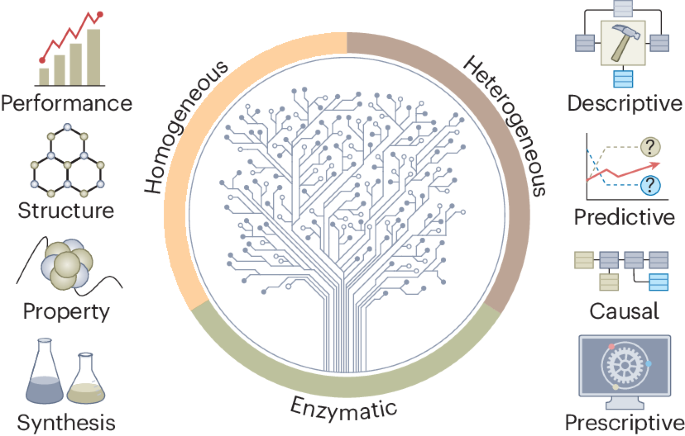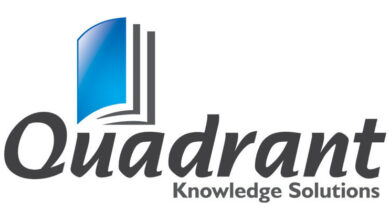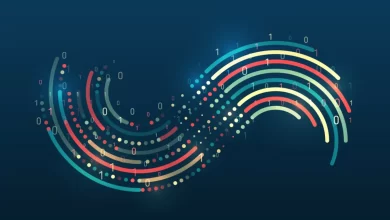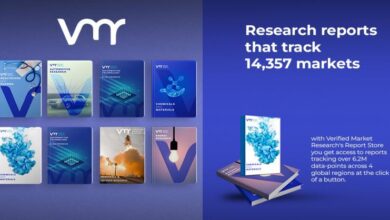Embracing data science in catalysis research

Vogt, C. & Weckhuysen, B. M. The concept of active site in heterogeneous catalysis. Nat. Rev. Chem. 6, 89–111 (2022).
Ye, R., Zhao, J., Wickemeyer, B. B., Toste, F. D. & Somorjai, G. A. Foundations and strategies of the construction of hybrid catalysts for optimized performances. Nat. Catal. 1, 318–325 (2018).
Copéret, C., Chabanas, M., Petroff Saint-Arroman, R. & Basset, J. M. Homogeneous and heterogeneous catalysis: bridging the gap through surface organometallic chemistry. Angew. Chem. Int. Ed. 42, 156–181 (2003).
Ye, R., Hurlburt, T. J., Sabyrov, K., Alayoglu, S. & Somorjai, G. A. Molecular catalysis science: perspective on unifying the fields of catalysis. Proc. Natl Acad. Sci. USA 113, 5159–5166 (2016).
Zhao, B., Han, Z. & Ding, K. The N-H functional group in organometallic catalysis. Angew. Chem. Int. Ed. 52, 4744–4788 (2013).
Sheldon, R. A. & Woodley, J. M. Role of biocatalysis in sustainable chemistry. Chem. Rev. 118, 801–838 (2018).
Munnik, P., de Jongh, P. E. & de Jong, K. P. Recent developments in the synthesis of supported catalysts. Chem. Rev. 115, 6687–6718 (2015).
Bornscheuer, U. T. et al. Engineering the third wave of biocatalysis. Nature 485, 185–194 (2012).
Grunwaldt, J.-D. & Schroer, C. G. Hard and soft X-ray microscopy and tomography in catalysis: bridging the different time and length scales. Chem. Soc. Rev. 39, 4741–4753 (2010).
Meirer, F. & Weckhuysen, B. M. Spatial and temporal exploration of heterogeneous catalysts with synchrotron radiation. Nat. Rev. Mater. 3, 324–340 (2018).
Chen, B. W. J., Xu, L. & Mavrikakis, M. Computational methods in heterogeneous catalysis. Chem. Rev. 121, 1007–1048 (2021).
Durand, D. J. & Fey, N. Computational ligand descriptors for catalyst design. Chem. Rev. 119, 6561–6594 (2019).
Wang, H. et al. Scientific discovery in the age of artificial intelligence. Nature 620, 47–60 (2023).
LeCun, Y., Bengio, Y. & Hinton, G. Deep learning. Nature 521, 436–444 (2015).
Kitchin, J. R. Machine learning in catalysis. Nat. Catal. 1, 230–232 (2018).
Toyao, T. et al. Machine learning for catalysis informatics: recent applications and prospects. ACS Catal. 10, 2260–2297 (2020).
Ma, X., Li, Z., Achenie, L. E. K. & Xin, H. Machine-learning-augmented chemisorption model for CO2 electroreduction catalyst screening. J. Phys. Chem. Lett. 6, 3528–3533 (2015).
Ahneman, D. T., Estrada, J. G., Lin, S., Dreher, S. D. & Doyle, A. G. Predicting reaction performance in C-N cross-coupling using machine learning. Science 360, 186–190 (2018). The application of interpretable machine learning on a high-throughput Buchwald–Hartwig dataset to predict high-performing palladium catalysts and unravel their inhibition mechanism.
Kim, M. et al. Searching for an optimal multi-metallic alloy catalyst by active learning combined with experiments. Adv. Mater. 34, 2108900 (2022).
Shields, B. J. et al. Bayesian reaction optimization as a tool for chemical synthesis. Nature 590, 89–96 (2021). Development of Bayesian optimization on palladium-catalysed Mitsunobu and deoxyfluorination reactions where the algorithm consistently outperformed human decision-making in terms number of experiments and actual yields to optimize the process.
Wu, Z., Kan, S. B. J., Lewis, R. D., Wittmann, B. J. & Arnold, F. H. Machine learning-assisted directed protein evolution with combinatorial libraries. Proc. Natl Acad. Sci. USA 116, 8852–8858 (2019).
Lu, H. et al. Machine learning-aided engineering of hydrolases for PET depolymerization. Nature 604, 662–667 (2022).
Ulissi, Z. W., Medford, A. J., Bligaard, T. & Nørskov, J. K. To address surface reaction network complexity using scaling relations machine learning and DFT calculations. Nat. Commun. 8, 14621 (2017).
Li, F. et al. Deep learning-based kcat prediction enables improved enzyme-constrained model reconstruction. Nat. Catal. 5, 662–672 (2022). A deep learning methodology to predict enzyme turnover numbers of metabolic enzymes from any organism merely from substrate structures and protein sequences.
Holeňa, M. & Baerns, M. Feedforward neural networks in catalysis: a tool for the approximation of the dependency of yield on catalyst composition and for knowledge extraction. Catal. Today 81, 485–494 (2003). Amongst the earliest reports on applied machine learning in catalysis, wherein a feedforward neural network was used to predict propene yield based on the catalyst composition.
Baumes, L., Farrusseng, D., Lengliz, M. & Mirodatos, C. Using artificial neural networks to boost high-throughput discovery in heterogeneous catalysis. QSAR Comb. Sci. 23, 767–778 (2004).
Burello, E., Farrusseng, D. & Rothenberg, G. Combinatorial explosion in homogeneous catalysis: screening 60,000 cross-coupling reactions. Adv. Synth. Catal. 346, 1844–1853 (2004).
Corma, A. et al. Optimisation of olefin epoxidation catalysts with the application of high-throughput and genetic algorithms assisted by artificial neural networks (softcomputing techniques). J. Catal. 229, 513–524 (2005).
Venkatasubramanian, V. The promise of artificial intelligence in chemical engineering: is it here, finally? AIChE J. 65, 466–478 (2019).
Pyzer-Knapp, E. O. et al. Accelerating materials discovery using artificial intelligence, high performance computing and robotics. NPJ Comput. Mater. 8, 84 (2022).
Pedregosa, F. et al. Scikit-learn: machine learning in Python. J. Mach. Learn. Res. 12, 2825–2830 (2011).
RDKit; https://www.rdkit.org/
Chanussot, L. et al. Open catalyst 2020 (OC20) dataset and community challenges. ACS Catal. 11, 6059–6072 (2021). The most extensive database consisting of close to 1.3 million density DFT relaxations across a wide swath of materials, surfaces and adsorbates (nitrogen, carbon and oxygen chemistries) for application in heterogeneous catalysis.
Kearnes, S. M. et al. The open reaction database. J. Am. Chem. Soc. 143, 18820–18826 (2021).
Yano, J. et al. The case for data science in experimental chemistry: examples and recommendations. Nat. Rev. Chem. 6, 357–370 (2022).
Schlexer Lamoureux, P. et al. Machine learning for computational heterogeneous catalysis. ChemCatChem 11, 3581–3601 (2019).
Medford, A. J., Kunz, M. R., Ewing, S. M., Borders, T. & Fushimi, R. Extracting knowledge from data through catalysis informatics. ACS Catal. 8, 7403–7429 (2018).
Maldonado, A. G. & Rothenberg, G. Predictive modeling in homogeneous catalysis: a tutorial. Chem. Soc. Rev. 39, 1891–1902 (2010).
Mazurenko, S., Prokop, Z. & Damborsky, J. Machine learning in enzyme engineering. ACS Catal. 10, 1210–1223 (2020).
Suvarna, M. & Pérez-Ramírez, J. Dataset: Embracing Data Science in Catalysis Research (Zenodo, 2024); https://doi.org/10.5281/zenodo.10640876
Zahrt, A. F. et al. Prediction of higher-selectivity catalysts by computer-driven workflow and machine learning. Science 363, eaau5631 (2019). The study models multiple conformations of more than 800 prospective catalysts for the coupling reaction of imines and thiols, and trained machine learning algorithms on a subset of experimental results, to achieve highly accurate predictions of enantioselectivities.
Nguyen, T. N. et al. High-throughput experimentation and catalyst informatics for oxidative coupling of methane. ACS Catal. 10, 921–932 (2020).
Tran, K. & Ulissi, Z. W. Active learning across intermetallics to guide discovery of electrocatalysts for CO2 reduction and H2 evolution. Nat. Catal. 1, 696–703 (2018). A fully automated screening method developed by integrating machine learning and optimization algorithms to guide DFT calculations, for in silico prediction of electrocatalyst performance for CO2 reduction and H2 evolution.
Wang, G. et al. Accelerated discovery of multi-elemental reverse water–gas shift catalysts using extrapolative machine learning approach. Nat. Commun. 14, 5861 (2023).
Amar, Y., Schweidtmann, A. M., Deutsch, P., Cao, L. & Lapkin, A. Machine learning and molecular descriptors enable rational solvent selection in asymmetric catalysis. Chem. Sci. 10, 6697–6706 (2019).
Rinehart, N. I. et al. A machine-learning tool to predict substrate-adaptive conditions for Pd-catalyzed C-N couplings. Science 381, 965–972 (2023).
Schweidtmann, A. M. et al. Machine learning meets continuous flow chemistry: automated optimization towards the pareto front of multiple objectives. Chem. Eng. J. 352, 277–282 (2018).
O’Connor, N. J., Jonayat, A. S. M., Janik, M. J. & Senftle, T. P. Interaction trends between single metal atoms and oxide supports identified with density functional theory and statistical learning. Nat. Catal. 1, 531–539 (2018).
Foppa, L. et al. Materials genes of heterogeneous catalysis from clean experiments and artificial intelligence. MRS Bull. 46, 1016–1026 (2021).
Zhao, S. et al. Enantiodivergent Pd-catalyzed C-C bond formation enabled through ligand parameterization. Science 362, 670–674 (2018).
Timoshenko, J., Lu, D., Lin, Y. & Frenkel, A. I. Supervised machine-learning-based determination of three-dimensional structure of metallic nanoparticles. J. Phys. Chem. Lett. 8, 5091–5098 (2017). Application of deep learning to solve metal catalyst from XANES, broadly applicable to the determination of nanoparticle structures in operando studies and generalizable to other nanoscale systems.
Zheng, C. et al. Automated generation and ensemble-learned matching of X-ray absorption spectra. NPJ Comput. Mater. 4, 12 (2018).
Mitchell, S. et al. Automated image analysis for single-atom detection in catalytic materials by transmission electron microscopy. J. Am. Chem. Soc. 144, 8018–8029 (2022).
Büchler, J. et al. Algorithm-aided engineering of aliphatic halogenase WelO5* for the asymmetric late-stage functionalization of soraphens. Nat. Commun. 13, 371 (2022).
Wulf, C. et al. A unified research data infrastructure for catalysis research – challenges and concepts. ChemCatChem 13, 3223–3236 (2021).
Mendes, P. S. F., Siradze, S., Pirro, L. & Thybaut, J. W. Open data in catalysis: from today’s big picture to the future of small data. ChemCatChem 13, 836–850 (2021).
Marshall, C. P., Schumann, J. & Trunschke, A. Achieving digital catalysis: strategies for data acquisition, storage and use. Angew. Chem. Int. Ed. 62, e202302971 (2023).
Zavyalova, U., Holena, M., Schlögl, R. & Baerns, M. Statistical analysis of past catalytic data on oxidative methane coupling for new insights into the composition of high-performance catalysts. ChemCatChem 3, 1935–1947 (2011).
Odabasi, C., Gunay, M. E. & Yildrim, R. Knowledge extraction for water gas shift reaction over noble metal catalysts from publications in the literature between 2002 and 2012. Int. J. Hydrog. Energy 39, 5733–5746 (2014).
Suvarna, M., Araújo, T. P. & Pérez-Ramírez, J. A generalized machine learning framework to predict the space-time yield of methanol from thermocatalytic CO2 hydrogenation. Appl. Catal. B Environ. 315, 121530 (2022).
Mamun, O., Winther, K. T., Boes, J. R. & Bligaard, T. High-throughput calculations of catalytic properties of bimetallic alloy surfaces. Sci. Data 6, 76 (2019).
Jinnouchi, R. & Asahi, R. Predicting catalytic activity of nanoparticles by a DFT-aided machine-learning algorithm. J. Phys. Chem. Lett. 8, 4279–4283 (2017).
Berman, H. M. et al. The protein data bank. Nucleic Acids Res. 28, 235–242 (2000).
Mitchell, A. L. et al. InterPro in 2019: improving coverage, classification and access to protein sequence annotations. Nucleic Acids Res. 47, D351–D360 (2019).
UniProt Consortium. UniProt: a worldwide hub of protein knowledge. Nucleic Acids Res. 47, D506–D515 (2019).
Schomburg, I., Chang, A. & Schomburg, D. BRENDA, enzyme data and metabolic information. Nucleic Acids Res. 30, 47–49 (2002).
Nagano, N. EzCatDB: the enzyme catalytic-mechanism database. Nucleic Acids Res. 33, D407–D412 (2005).
Finnigan, W. et al. RetroBioCat as a computer-aided synthesis planning tool for biocatalytic reactions and cascades. Nat. Catal. 4, 98–104 (2021).
Winther, K. T. et al. Catalysis-Hub.org, an open electronic structure database for surface reactions. Sci. Data 6, 75 (2019).
Álvarez-Moreno, M. et al. Managing the computational chemistry big data problem: the ioChem-BD platform. J. Chem. Inf. Model. 55, 95–103 (2015).
Gensch, T. et al. A comprehensive discovery platform for organophosphorus ligands for catalysis. J. Am. Chem. Soc. 144, 1205–1217 (2022).
Bengio, Y., Courville, A. & Vincent, P. Representation learning: a review and new perspectives. IEEE Trans. Pattern Anal. Mach. Intell. 35, 1798–1828 (2013).
Schmidt, J., Marques, M. R. G., Botti, S. & Marques, M. A. L. Recent advances and applications of machine learning in solid-state materials science. NPJ Comput. Mater. 5, 83 (2019).
Sanchez-Lengeling, B. & Aspuru-Guzik, A. Inverse molecular design using machine learning: generative models for matter engineering. Science 361, 360–365 (2018).
Mitchell, J. B. O. Machine learning methods in chemoinformatics. WIREs Comput. Mol. Sci. 4, 468–481 (2014).
Wigh, D. S., Goodman, J. M. & Lapkin, A. A. A review of molecular representation in the age of machine learning. WIREs Comput. Mol. Sci. 12, e1603 (2022).
Krenn, M., Häse, F., Nigam, A., Friederich, P. & Aspuru-Guzik, A. Self-referencing embedded strings (SELFIES): a 100% robust molecular string representation. Mach. Learn. Sci. Technol. 1, 045024 (2020).
Kononova, O. et al. Text-mined dataset of inorganic materials synthesis recipes. Sci. Data 6, 203 (2019).
Olivetti, E. A. et al. Data-driven materials research enabled by natural language processing and information extraction. Appl. Phys. Rev. 7, 041317 (2020).
Kim, E. et al. Materials synthesis insights from scientific literature via text extraction and machine learning. Chem. Mater. 29, 9436–9444 (2017).
Jensen, Z. et al. A machine learning approach to zeolite synthesis enabled by automatic literature data extraction. ACS Cent. Sci. 5, 892–899 (2019).
Luo, Y. et al. MOF synthesis prediction enabled by automatic data mining and machine learning. Angew. Chem. Int. Ed. 61, e202200242 (2022).
Zheng, Z., Zhang, O., Borgs, C., Chayes, J. T. & Yaghi, O. M. ChatGPT chemistry assistant for text mining and the prediction of MOF synthesis. J. Am. Chem. Soc. 145, 18048–18062 (2023).
Suvarna, M., Vaucher, A. C., Mitchell, S., Laino, T. & Pérez-Ramírez, J. Language models and protocol standardization guidelines for accelerating synthesis planning in heterogeneous catalysis. Nat. Commun. 14, 7964 (2023).
Lai, N. S. et al. Artificial intelligence (AI) workflow for catalyst design and optimization. Ind. Eng. Chem. Res. 62, 17835–17848 (2023).
Probst, D. et al. Biocatalysed synthesis planning using data-driven learning. Nat. Commun. 13, 964 (2022).
Moon, J. et al. Active learning guides discovery of a champion four-metal perovskite oxide for oxygen evolution electrocatalysis. Nat. Mater. 23, 108–115 (2024).
Zhong, M. et al. Accelerated discovery of CO2 electrocatalysts using active machine learning. Nature 581, 178–183 (2020). Discovery of Cu-Al electrocatalysts, though DFT aided machine learning, to efficiently reduce CO2 to ethylene with a Faradaic efficiency of 80%.
Torres, J. A. G. et al. A multi-objective active learning platform and web app for reaction optimization. J. Am. Chem. Soc. 144, 19999–20007 (2022).
Greenhalgh, J. C., Fahlberg, S. A., Pfleger, B. F. & Romero, P. A. Machine learning-guided acyl-ACP reductase engineering for improved in vivo fatty alcohol production. Nat. Commun. 12, 5825 (2021).
Tallorin, L. et al. Discovering de novo peptide substrates for enzymes using machine learning. Nat. Commun. 9, 5253 (2018).
Schwaller, P. et al. Molecular transformer: a model for uncertainty-calibrated chemical reaction prediction. ACS Cent. Sci. 5, 1572–1583 (2019).
Anstine, D. M. & Isayev, O. Generative models as an emerging paradigm in the chemical sciences. J. Am. Chem. Soc. 145, 8736–8750 (2023).
Gómez-Bombarelli, R. et al. Automatic chemical design using a data-driven continuous representation of molecules. ACS Cent. Sci. 4, 268–276 (2018). A method to convert discrete representations of molecules into multidimensional continuous representations for generating compounds in silico.
Repecka, D. et al. Expanding functional protein sequence spaces using generative adversarial networks. Nat. Mach. Intell. 3, 324–333 (2021).
Hawkins-Hooker, A. et al. Generating functional protein variants with variational autoencoders. PLoS Comput. Biol. 17, e1008736 (2021).
Johnson, S. R. et al. Computational scoring and experimental evaluation of enzymes generated by neural networks. Preprint at https://www.biorxiv.org/content/10.1101/2023.03.04.531015v1 (2023).
Schilter, O., Vaucher, A., Schwaller, P. & Laino, T. Designing catalysts with deep generative models and computational data. A case study for Suzuki cross coupling reactions. Digit. Discov. 2, 728–735 (2023).
Kreutter, D., Schwaller, P. & Reymond, J.-L. Predicting enzymatic reactions with a molecular transformer. Chem. Sci. 12, 8648–8659 (2021).
Popova, M., Isayev, O. & Tropsha, A. Deep reinforcement learning for de novo drug design. Sci. Adv. 4, eaap7885 (2018).
Zhou, Z., Li, X. & Zare, R. N. Optimizing chemical reactions with deep reinforcement learning. ACS Cent. Sci. 3, 1337–1344 (2017). A fully automated deep reinforcement learning to optimize chemical reactions where the model iteratively records the results of a chemical reaction and chooses new experimental conditions to improve the reaction outcome.
Lan, T. & An, Q. Discovering catalytic reaction networks using deep reinforcement learning from first-principles. J. Am. Chem. Soc. 143, 16804–16812 (2021).
Song, Z. et al. Adaptive design of alloys for CO2 activation and methanation via reinforcement learning Monte Carlo tree search algorithm. J. Phys. Chem. Lett. 14, 3594–3601 (2023).
Suvarna, M., Preikschas, P. & Pérez-Ramírez, J. Identifying descriptors for promoted rhodium-based catalysts for higher alcohol synthesis via machine learning. ACS Catal. 12, 15373–15385 (2022).
Smith, A., Keane, A., Dumesic, J. A., Huber, G. W. & Zavala, V. M. A machine learning framework for the analysis and prediction of catalytic activity from experimental data. Appl. Catal. B Environ. 263, 118257 (2020).
Vellayappan, K. et al. Impacts of catalyst and process parameters on Ni-catalyzed methane dry reforming via interpretable machine learning. Appl. Catal. B Environ. 330, 122593 (2023).
Roh, J. et al. Interpretable machine learning framework for catalyst performance prediction and validation with dry reforming of methane. Appl. Catal. B Environ. 343, 123454 (2024).
McCullough, K., Williams, T., Mingle, K., Jamshidi, P. & Lauterbach, J. High-throughput experimentation meets artificial intelligence: a new pathway to catalyst discovery. Phys. Chem. Chem. Phys. 22, 11174–11196 (2020).
Suzuki, K. et al. Statistical analysis and discovery of heterogeneous catalysts based on machine learning from diverse published data. ChemCatChem 11, 4537–4547 (2019).
Butler, K. T., Davies, D. W., Cartwright, H., Isayev, O. & Walsh, A. Machine learning for molecular and materials science. Nature 559, 547–555 (2018).
Oviedo, F., Ferres, J. L., Buonassisi, T. & Butler, K. T. Interpretable and explainable machine learning for materials science and chemistry. Acc. Mater. Res. 3, 597–607 (2022).
Esterhuizen, J. A., Goldsmith, B. R. & Linic, S. Interpretable machine learning for knowledge generation in heterogeneous catalysis. Nat. Catal. 5, 175–184 (2022).
Wu, K. & Doyle, A. G. Parameterization of phosphine ligands demonstrates enhancement of nickel catalysis via remote steric effects. Nat. Chem. 9, 779–784 (2017).
Weng, B. et al. Simple descriptor derived from symbolic regression accelerating the discovery of new perovskite catalysts. Nat. Commun. 11, 3513 (2020).
Ouyang, R., Curtarolo, S., Ahmetcik, E., Scheffler, M. & Ghiringhelli, L. M. SISSO: a compressed-sensing method for identifying the best low-dimensional descriptor in an immensity of offered candidates. Phys. Rev. Mater. 2, 083802 (2018).
Foppa, L. et al. Data-centric heterogeneous catalysis: identifying rules and materials genes of alkane selective oxidation. J. Am. Chem. Soc. 145, 3427–3442 (2023).
Li, Z., Ma, X. & Xin, H. Feature engineering of machine-learning chemisorption models for catalyst design. Catal. Today 280, 232–238 (2017).
Lundberg, S. M. et al. From local explanations to global understanding with explainable AI for trees. Nat. Mach. Intell. 2, 56–67 (2020).
Timoshenko, J. et al. Linking the evolution of catalytic properties and structural changes in copper-zinc nanocatalysts using operando EXAFS and neural-networks. Chem. Sci. 11, 3727–3736 (2020).
Wilkinson, M. D. et al. The FAIR guiding principles for scientific data management and stewardship. Sci. Data 3, 160018 (2016).
Scheffler, M. et al. FAIR data enabling new horizons for materials research. Nature 604, 635–642 (2022).
Abolhasani, M. & Kumacheva, E. The rise of self-driving labs in chemical and materials sciences. Nat. Synth. 2, 483–492 (2023). A review of self-driving labs through the integration of machine learning, lab automation and robotics to accelerate digital data curation and enable data-driven discoveries in chemical sciences.
MacLeod, B. P. et al. Self-driving laboratory for accelerated discovery of thin-film materials. Sci. Adv. 6, eaaz8867 (2020).



